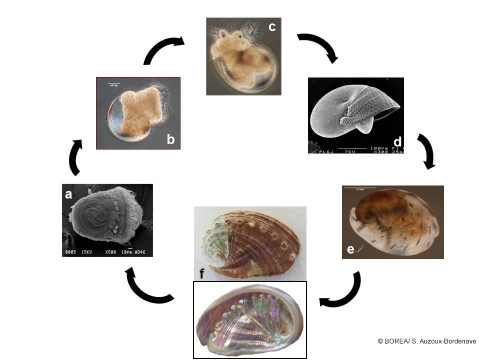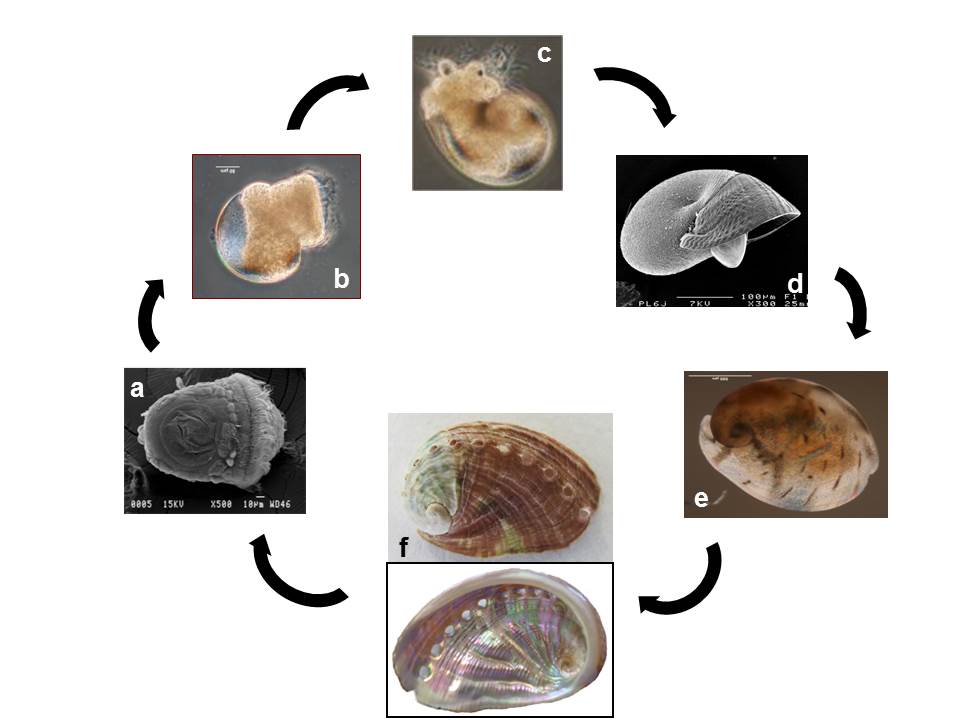
As a consequence of global change, mean surface temperature is projected to increase by 1 to 3°C while surface ocean pH should decrease by 0.1 to 0.3 units for the late 21st century. Marine ecosystems and global production of marine resources may therefore be seriously impacted by these environmental changes. Because they use calcium carbonate (CaC03) to produce their calcareous shell, marine molluscs are among the most vulnerable invertebrates to acidification. The abalone Haliotis tuberculata is a commercially important food source for which the whole life-cycle is mastered in aquaculture. Larval development and shell formation have been extensively studied in H. tuberculata, showing that the aragonite shell is highly sensitive to ocean acidification. Abalone embryos were also shown to be dramatically affected by a combination of warm and acidified conditions. Our recent works on the European abalone have evidenced that a decreased pH induced larval development abnormalities and delay in shell calcification (Figure 1). Since its basic biology is well understood and its whole life cycle is mastered in aquaculture, the abalone H. tuberculata is a relevant model organism for investigating the effects of future ocean conditions.
In this context, the project aims at assessing the potential impacts of decreased pH on larva and juvenile abalone grown from spawning of the exposed adults. By using a combination of morphological, developmental and behavioural approaches, we will show how predicted ocean conditions are likely to affect key physiological processes throughout the life-history stages of the abalone. The effects of decreased pH will be first evaluated on adult gonad development, fertility and gamete quality. The responses of embryos, larvae and juveniles will be monitored by measuring survival rate, morphology and growth. Microscopy and structural techniques will be used to investigate the effects of acidification/warming on microstructure, chemical composition and mechanical properties of the shell. Biological, physiological as well as behavioural responses measured over life-history stages may provide valuable information regarding acclimation and adaptation of abalone to a changing ocean.

Figure 1: life cycle of the european abalone Haliotis tuberculata a: early-hatched trochophore larve (19h), b: veiger larvae (31h), c: metamorphic larvae (5d) , d: benthic post-larvae (10j), e: juvenile abalone (2 months), f: adult abalone in external and internal view. Photos S. Auzoux-Bordenave
Partners:
Laboratoire LEMAR (UBO, Brest)
Station biologique de Roscoff (AD2M)
Laboratoire de Biologie Marine (ULB, Bruxelles)
Ecloserie France-Haliotis (Plouguerneau)
Current program (from 3.01.2017)
For 12 months
Funds come from "Actions Transversales du Muséum National d'Histoire Naturelle"
Contact:
Stéphanie Auzoux-Bordenave, assistant professor UPMC, Team 4 - Research Unit BOREA, stephanie.auzoux-bordenave@mnhn.fr
